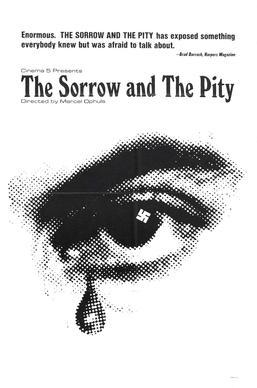Exploring “The Sorrow and the Pity” – A Cinematic Reflection on Memory and Morality
In a world increasingly defined by polarized narratives and contentious historical interpretations, “The Sorrow and the Pity” stands as a pivotal work that delves into the complexities of memory, responsibility, and the human condition. Originally released in 1969, this landmark documentary by Marcel Oph√ľls offers a profound examination of life under Nazi occupation in France, interweaving personal testimonies with chilling archival footage.
As the film gains renewed relevance in today’s socio-political landscape, Reverse Shot revisits Oph√ľls’ exploration of collective guilt and historical amnesia. Through the lens of its enduring impact and the ongoing discourse surrounding its themes, this article seeks to illuminate how “The Sorrow and the Pity” not only shaped the documentary genre but also continues to challenge audiences to confront uncomfortable truths about the past. Join us as we unravel the film‚Äôs intricate narrative and its implications for contemporary society.
Exploring the Duality of Human Experience in The Sorrow and the Pity
The narrative woven in The Sorrow and the Pity encapsulates the complexities of human nature against the backdrop of war and moral ambiguity. Through meticulous interviews and historical records, the film thrusts viewers into the unsettling realities faced by individuals during the French Resistance and collaboration with Nazi forces. It raises essential questions about complicity, survival, and moral integrity. As audiences engage with the contrasting stories of heroism and betrayal, the film invites them to ponder the weight of personal choices amid collective despair.
The duality of human experience manifests in characters who embody both victimhood and agency. The documentary style underscores this paradox, revealing the human capacity for empathy alongside willingness to overlook atrocities. Key figures, divided by their actions during the Occupation, serve as poignant reminders of how easily one’s moral compass can veer off course. The film effectively articulates this tension through a series of stark interviews that present a tableau of emotions, including:
- Guilt stemming from collaboration.
- Heroism of those who resisted.
- Denial among those who turned a blind eye.
In examining these narratives, we witness not only the historical dimension of the events but also the psychological intricacies that shape individual actions during crises, illustrating the enduring relevance of the themes presented in this seminal work.
Analyzing Historical Context and Its Modern Relevance
In examining the complexities of Jean-Luc Godard’s *The Sorrow and the Pity*, it becomes evident that the film serves as both a historical document and a lens through which contemporary audiences can evaluate the implications of collective memory. The juxtaposition of personal narratives with broader socio-political realities invites us to consider how societal trauma can shape national identities. The themes presented through archival footage and interviews resonate deeply in today’s discourse, urging us to reflect on the following:
- The Power of Narrative: How stories shape our understanding of history
- Collective Memory: The role of shared experiences in wartime
- Modern Parallels: Current events that mirror past conflicts
Furthermore, the film’s exploration of collaboration versus resistance raises critical questions about complicity and moral choices during oppressive regimes. The relevance of these themes in our current climate is striking; as we witness the resurgence of populism and authoritarianism worldwide, it becomes essential to grapple with the moral imperatives of our time. The following table highlights key comparisons between historical and contemporary contexts that illustrate this relevance:
| Historical Aspect | Modern Context |
|---|---|
| Resistance Movements | Modern Civil Rights Protests |
| Propaganda Techniques | Social Media Manipulation |
| Ethical Dilemmas | Whistleblowing and Accountability |
Cinematic Techniques that Enhance Emotional Impact
In examining the profound emotional resonance within The Sorrow and the Pity, the use of the reverse shot technique stands out as a pivotal cinematic device. This approach creates a powerful dialogue not just between characters, but also between the audience and the unfolding narrative. The reverse shot allows viewers to witness the grief and conflict reflected in the characters’ eyes, often capturing fleeting moments of vulnerability that evoke deep empathy. By contrasting the perspectives of the subjects, the film enhances emotional layers, drawing attention to the shared human experience of loss and mourning.
Utilizing reverse shots strategically, directors cultivate a deeper connection to the storyline, prompting audiences to process the weight of each character’s story. The composition of these shots is crucial; they often depict close-ups that reveal subtle facial expressions and emotional nuances. Consider the following elements that contribute to the emotional impact:
| Element | Description |
|---|---|
| Framing | Focus on reactions to amplify emotional stakes. |
| Lighting | Utilize shadows to evoke melancholy moods. |
| Sound Design | Integrate ambient sounds to heighten tension. |
| Editing Pace | Slow down cuts during pivotal moments to prolong emotional weight. |
These elements work in unison to create an atmosphere rife with tension and poignancy. The reverse shot technique, with its ability to juxtapose opposing emotional states, not only enhances dramatic effect but also invites viewers into an intimate reflection on their own experiences of sorrow and regret. It is this intricate layering of visual storytelling that makes The Sorrow and the Pity resonate deeply, transforming simple exchanges into monumental moments of truth.
Recommendations for Further Viewing and Critical Discussion
For those intrigued by the themes presented in “The Sorrow and the Pity,” a variety of films provoke further introspection on collective memory and historical trauma. Consider exploring:
- Holocaust Documentaries: Films like “Shoah” by Claude Lanzmann provide an unflinching look at the long-lasting impacts of genocide.
- Modern War Films: “The Fog of War,” directed by Errol Morris, offers an insightful examination of morality in warfare through the lens of Robert S. McNamara.
- Historical Dramas: “Come and See” presents a haunting narrative on the consequences of war, particularly in relation to civilian suffering.
Engaging in critical discussion about such works can yield profound insights into societal complicity and the narratives we choose to remember or forget. Some recommended texts to accompany these viewings might include:
| Title | Author | Key Themes |
|---|---|---|
| ‚ÄúOrdinary Men‚ÄĚ | Christopher R. Browning | Complicity, Humanity, War Crimes |
| ‚ÄúThe History of the Present‚ÄĚ | David N. Myers | Memory, Identity, Historical Revisionism |
Insights and Conclusions
Conclusion
In the realm of documentary filmmaking, ‚ÄúThe Sorrow and the Pity‚ÄĚ stands as a sobering exploration of complicity and resistance during one of history’s darkest periods. Reverse Shot‚Äôs analysis sheds light on the nuanced storytelling techniques employed in the film, highlighting its profound impact on our understanding of collective memory and moral ambiguity. As we confront the legacies of our past, the film serves as a poignant reminder of the importance of historical reflection and the choices that define our humanity. As discussions around accountability and remembrance continue to evolve, the themes presented by Marcel Oph√ľls resonate perhaps more strongly than ever, urging audiences to engage critically with the narratives that shape our present. In an era where the lessons of history remain all too relevant, ‚ÄúThe Sorrow and the Pity‚ÄĚ transcends its time, fostering necessary dialogue and deeper contemplation about the nature of justice and ethical responsibility.




